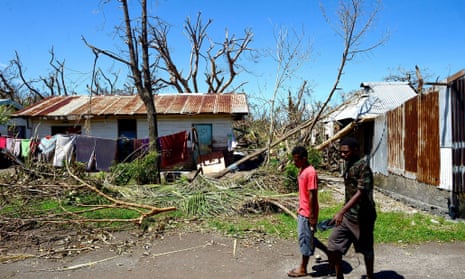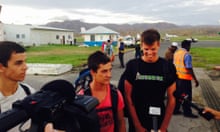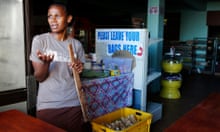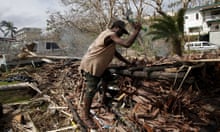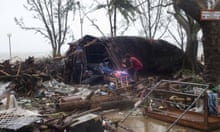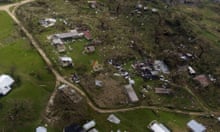Vanuatu’s prime minister has urged citizens to “plant their own gardens and survive” on a tour of the areas most affected by cyclone Pam – and told them that they have become too dependent on government due to French colonial rule.
Joe Natuman’s visit to Tanna came days after the category five cyclone laid waste to the island, leaving thousands homeless and water and food supplies dwindling.
Residents told of a terrifying and unprecedented storm that lingered for hours, flattening whole villages, wiping out subsistence crops and damaging or destroying more than three -quarters of all homes on the island.
Some questioned the lack of visible support from the Vanuatu government, which has struggled to mount an immediate response with communications networks destroyed, and is heavily reliant on Australia, New Zealand and France for the aid effort.
Natuman, who arrived on a New Zealand military plane, told reporters at Tanna airport that while large-scale aid had begun to arrive on the island, people should eat what food the cyclone had left behind before the government stepped in.
He said aid would initially focus on shelters and “probably water” before turning to food supplies later on.
Asked what message of hope he could offer Tanna, Natuman paid tribute to locals’ resilience before criticising French colonialism and what he said was an over-dependence on government.
The prime minister said: “They have been existing for thousands of years, they’ve been facing all these natural disasters.
And then the president of France came, and even when they were here, hardly anything then went to the people, only now, people are too dependent on government.
“Of course, I suppose it’s government business to service the people, but people have to be able to survive on their own, to be self-sufficient. The government will be providing some relief measures: food, shelter. But they will have to, in the long run, plant their own gardens and survive.”
Greg Tom, who was staying with his family in an evacuation centre in the village of Lownatum, said a community of more than 1,000 people had been made homeless, lacked access to medicine and was already deeply concerned about food and water.
He said: “We are waiting for the Vanuatu government. I haven’t seen them. I mean, they are trying something but we don’t know, we just hear this. We just cross our fingers and wait.”
While the government puts the death toll from Pam at 11, including five in Tanna, a report by the provincial authorities estimates that seven people have died on the island.
They include an elderly woman and her daughter, who were killed when a church they were sheltering in at Lamkail collapsed, according to local reports. A woman in Lapangtawa was decapitated by flying roofing iron, which also killed her son when he went to her aid, while another man died in a roofing collapse.
A nine-year-old girl who sustained a serious head injury when the roof in her home collapsed was airlifted from Tanna hospital, where the Australian medical assistance team was confronted with facilities barely capable of dealing with broken bones.
In the hospital, , Rhiannon Wake, a nurse, said the team she worked with had seen a lot more damage and more injuries in the Philippines after typhoon Haiyan in 2013.
She said: “We’re not seeing the same thing here but, in saying that, there are a lot more regional areas which haven’t been seen yet.”
There are an estimated 10,000 people that the authorities have not been able to reach in the wider province of Tafea. Natuman said lines of communication were open on Tanna but he had no details about conditions on other islands.
Aid agencies believe more than half of the 32,000 people in Tafea province are in shelters, with many more homeless.
Ruth Louhman, who said her home was one of only three in her community to escape destruction, was replanting cabbages on Wednesday. She said: “Wipeout in a minute and we have to start again. We’re eating starches, fruits and we cannot survive if we don’t eat the ones fallen from the trees and the ones that were pulled up. (They will) last two or three weeks’ time.”
Tom said: “The main worry for us is that people will (go) hungry in a month. We’re still using the rest of what the cyclone has left but after a month or two, that’s going to be a big worry for everyone.”
Water is a major problem, as it is only available in coastal bores, which people in inland communities must travel long distances to reach.
Asked about his personal reaction to the disaster, Natuman said he was very saddened. He added: “Of course, this is an act of disaster, an act of God, and we’re hoping we will survive.”
